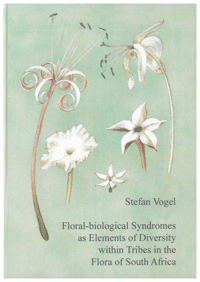
Catalogus : Recensies
Recensies

|
Stefan Vogel Floral-biological Syndromes as Elements of Diversity within Tribes in the Flora of South Africa Translation of the German original edition from 1954, Translation into English by Elke Pischtschan, Editing of the translation by Kathryn B. Johnson and Steven D. Johnson ISBN: 978-3-8440-0599-8 Prijs: 49,80 € / 62,25 SFR |
|---|---|
|
Stefan Vogel was born in Germany in 1925 and can be considered as one of the leading floral biologists of the 20th century. The book is based on his findings from a year-long expedition to South Africa in
1950–1951. First published in German in 1954 and recently translated into English, this monograph, represents the first comprehensive work on floral syndromes. The concept is illustrated in detail using examples from the South African flora. This pioneering work shows how unrelated plant species, that share guilds of pollinators (e.g. bees, butterflies moths, flies, birds), have similar combinations of floral traits (shape, colour, scent and nectar properties). As the readership of the German language edition of Vogel´s book was limited, many pollination biologists in the English-speaking world tended to associate the concept of pollination syndromes with the various editions of The Principles of Pollination Ecology written by Knut Faegri and Leendert Van der Pijl in the 1960s and 1970s. With the present translation, this important landmark in pollination biology is now available to a broader readership. In the first part of the book, the author explains the historical development of the pollination syndrome concept, which dates back to the Italian Federico Delpino in the 19th century. Vogel outlines various floral characters and syndromes and shows how different philosophies (e.g. Darwinism, teleology) influenced the historical development of the concept. In the second part of the book, Vogel describes several syndromes exhibited by the South African flora as well as prominent pollinator groups in South Africa such as birds and long-tongued flies. In the third and most extensive part of the book, the author demonstrates the syndrome concept. He presents detailed, mainly field-based studies of flowers of about 1000, mainly South African, plant species in more than 300 genera belonging to more than 50 families. He often describes his observations of floral visitors. The results are beautifully illustrated by his own incredibly detailed and realistic drawings and paintings, as well as several black and white photographs. Presenting the plant species in systematic order, Vogel emphasizes that different pollination syndromes can be realised within the same systematic tribe and genus. This indicates the important role of pollinators in the adaptive radiation of the South African flora. This part of the book is particularly valuable as a reference work and as a motivation and basis for further field studies on pollination ecology. The validity of the syndrome concept was confirmed by Vogel´s subsequent work in South America, where he also discovered pollination by bats and perfume- and oil-collecting bees. However, the concept has been criticised in the past 20 years for being overly typological and also because apparently specialised flowers show much more ecological generalisation than expected. The first point of criticism might date from the belief that the syndrome concept strictly classifies flowers. However, Vogel explains that (pollination) syndromes have no sharp boundaries, allowing also less typical representatives and even transitional forms. The second point of criticism has been refuted by numerous studies in different parts of the world, especially in the tropics and in the Cape Flora. These studies have shown high degrees of specialisation of plants to specific pollinators. Thus natural selection by major pollinators on floral traits is reflected in pollination systems. Additionally, it has been repeatedly shown that pollination syndromes are a useful guide in the generation of testable hypotheses about the identity of unknown pollinators. In a nutshell, this book is a ‘must have‘, not only for those with a special interest in pollination ecology or the South African flora, but also for anyone with an interest in plant evolution. It should be on the shelves of all University libraries. Petra Wester School of Life Sciences, University of KwaZulu-Natal Pietermaritzburg, Private Bag X01, Scottsville 3201, South Africa |
|
| Bron: South African Journal of Botany 87 (2013) 84 | |
| verder naar publicatie ... | |